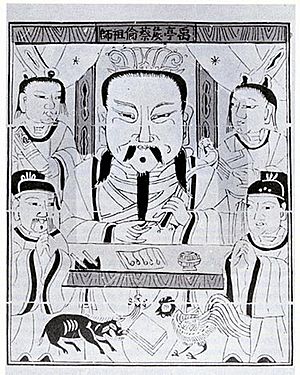Cai Lun facts for kids
Quick facts for kids
Cai Lun
|
|
|---|---|
| 蔡倫 蔡伦 |
|

|
|
| Born | c. 50–62 CE |
| Died | 121 CE (aged 59–71) |
| Occupation | Eunuch court official
Court positions
Xiao Huangmen (c. 80–88) Zhongchang shi (88–121) Shangfang Ling (88/89–121) |
| Known for | Development of paper and papermaking |
| Cai Lun | |||||||||||||||||||||||||||||||||||||||
|---|---|---|---|---|---|---|---|---|---|---|---|---|---|---|---|---|---|---|---|---|---|---|---|---|---|---|---|---|---|---|---|---|---|---|---|---|---|---|---|

Cai's name in Traditional (top) and Simplified (bottom) Chinese characters
|
|||||||||||||||||||||||||||||||||||||||
| Traditional Chinese | 蔡倫 | ||||||||||||||||||||||||||||||||||||||
| Simplified Chinese | 蔡伦 | ||||||||||||||||||||||||||||||||||||||
|
|||||||||||||||||||||||||||||||||||||||
| Jingzhong (courtesy name) |
|||||||||||||||||||||||||||||||||||||||
| Traditional Chinese | 敬仲 | ||||||||||||||||||||||||||||||||||||||
| Simplified Chinese | 敬仲 | ||||||||||||||||||||||||||||||||||||||
|
|||||||||||||||||||||||||||||||||||||||
Cai Lun (Chinese: 蔡伦; courtesy name: Jingzhong (Chinese: 敬仲; ); c. 50–62 – 121 CE) was a Chinese court official during the Eastern Han dynasty. He is known for greatly improving the way paper was made. While some early forms of paper existed before him, Cai Lun made paper much better by adding new materials like pulp from tree bark and hemp waste. This made it possible to make paper on a large scale and helped it spread all over the world.
Cai Lun's Early Life and Career
Born in Guiyang
Cai Lun was born in Guiyang Commandery (which is now Leiyang, Hunan province, China). We don't know his exact birth year, but it was around 50 to 62 CE. He came from a poor family.
Working for the Emperor
Cai Lun became a eunuch (a special type of court official) and started working for the imperial court in Luoyang around 75 CE. He first served Emperor Ming as a chamberlain, which meant he helped manage the imperial household.
Later, he became an imperial messenger for Emperor Zhang. This job involved delivering important messages between the emperor and others. Cai Lun was known for being honest and good at his job.
Rise in the Palace
When Emperor He became emperor in 88 CE, Cai Lun was given two important jobs. He became a political advisor to the emperor, which was the highest position for eunuchs at that time. He also became the "Prefect of the Palace Workshop." In this role, Cai Lun was in charge of making instruments and weapons for the emperor's use. The items he oversaw were known for their excellent quality.
Cai Lun's Big Invention: Paper
Why Paper Was Needed
Before Cai Lun, people in China wrote on bamboo and wooden slips. These were heavy and hard to store. They also used silk, which was much lighter but very expensive. There was a great need for a better, cheaper writing material.
How Cai Lun Improved Paper
In 105 CE, Cai Lun announced that he had found a new and much better way to make paper. His method used materials like tree bark (especially from mulberry trees), hemp waste, old rags, and fishing nets.
Here's how his process worked:
- The materials were boiled until they turned into a soft pulp.
- This pulp was then beaten with a wooden or stone hammer.
- Next, it was mixed with a lot of water.
- The mixture was spread onto wooden sieves to drain the excess water.
- Once dry, the thin layer left on the sieve became paper!
This new paper was called "Cai Hou paper" (meaning "paper of Lord Cai"). It quickly replaced the old bamboo and silk, making writing and sharing information much easier and cheaper.
Later Life and Death
Cai Lun continued to be an important official. In 114 CE, he was honored with the title of marquis and became the lord of a small village called Longting.
However, when his political allies lost power in 121 CE, Cai Lun faced serious trouble. He was ordered to report to the Ministry of Justice to answer charges related to past political events. Rather than face this, Cai Lun chose to end his own life. He died in the capital city where he had spent most of his adult life.
Cai Lun's Amazing Legacy
Paper Spreads Worldwide
Cai Lun's improvements to papermaking had a huge impact on human history. Paper made it possible for knowledge and stories to spread easily around the world. It helped advance communication and learning.
Even though paper existed before him, Cai Lun's methods made it practical for everyone. Because of his important work, he is still traditionally seen as the inventor of paper.
- To Japan and Beyond: According to legend, a Buddhist monk named Damjing brought the papermaking process to Japan.
- To the Arab World and Europe: By the 600s, paper technology reached places like Turkestan, Korea, and India. Chinese prisoners from the Battle of Talas shared the knowledge with Arabs. From the Arab world, papermaking gradually spread to Europe by the 12th century.
Cai Lun is one of the few inventors from China's Four Great Inventions (the compass, gunpowder, papermaking, and printing) whose name is known. In 2010, the International Astronomical Union even named a crater on the Moon after him!
Cai Lun in China
Fun Folktales
There are many popular stories about Cai Lun. One tale says that after he invented his new paper, not many people wanted to buy it. So, Cai Lun and his wife came up with a clever plan. They told everyone that if you burned paper, it would turn into money in the afterlife!
In one version of the story, Cai Lun's brother, Cai Mo, and his wife, Hui Niang, are involved. Hui Niang pretended to die, and Cai Mo stood by her coffin, crying loudly and burning paper money. When neighbors came to check, Hui Niang suddenly jumped out of the coffin! She explained that the burned paper money had reached her in the afterlife, and she used it to pay ghosts to bring her back to life. Believing the story, people quickly bought lots of paper to burn for their own families. While this is just a story, burning paper offerings is a common tradition in Chinese culture.
Honored as a God
Cai Lun is highly respected in China. He was made a god and is known as the national god of papermaking. Papermakers in China and Japan often honor him as their patron saint.
In 1267, a man named Chen Tsunghsi helped repair Cai Lun's shrine and tomb in his hometown. Today, the Cai Lun Temple still stands in Leiyang, near a pool renamed the "Cai Lun Pool." This area is still famous for paper production.
Cai Lun's name is so connected to paper that many roads and even a museum in China are named after him, like the Cai Lun Paper Culture Museum.
Images for kids
-
Woodcuts depicting the five seminal steps in ancient Chinese papermaking. From the 1637 Tiangong Kaiwu of the Ming dynasty.
-
The Three Gods of Paper-making, Cai Lun (in the middle) with the Korean monk Damjing (on the left), who brought the art to Japan, and Mochizuki Seibei (who brought the art to Nishijima (西嶋)) Kept in the Minobu Town Museum of History and Folklore
See also
 In Spanish: Cai Lun para niños
In Spanish: Cai Lun para niños



